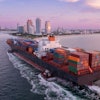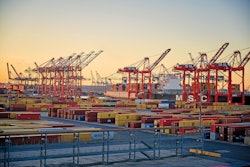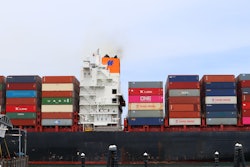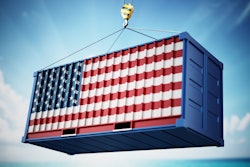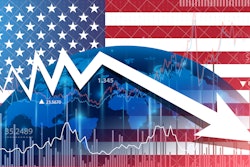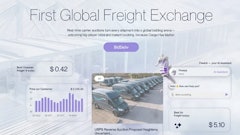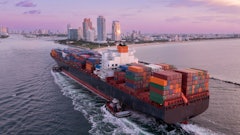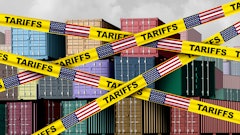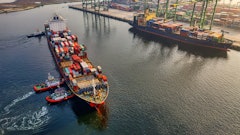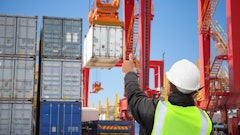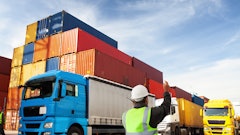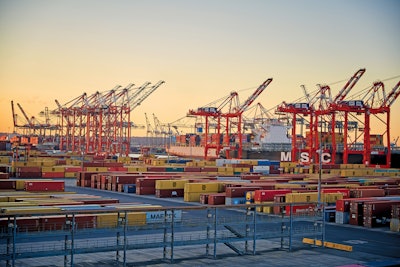
When it comes to U.S. ports and ocean carriers, it’s safe to say that for a sector traditionally stagnant, it’s experienced a great deal of change over the past couple of years.
From dockworker strikes and heightened adoption of nearshoring to an uptick in fuel charges, a deteriorated infrastructure and economic uncertainty with regards to increased tariffs, the ripple effect has been – and will continue to be -- felt across all ports nationwide.
But what does this all mean for 2025? And what will the State of Ports and Ocean Carriers look like in the New Year?
U.S. ports are responsible for nearly $2.9 trillion in economic activity and 21.8 million American jobs, according to a study released by the American Association of Port Authorities (AAPA).
The maritime industry, its consumer spending, suppliers, and port users support 21.8 million American jobs. That means the port and maritime industry supports more than one out of eight jobs in the total U.S. workforce. Total employment supported port and maritime activity is larger than the workforce in 90% of U.S. metropolitan areas.
The average wage of a port and maritime employee is almost $100,000, which is 20% more than the average U.S. worker. Ports’ contribution to U.S. Gross Domestic Product (GDP) totals almost $2.9 trillion. The wages and benefits supported by ports and maritime activities totals almost $2.8 trillion. And, more than $2.1 trillion passed through a port, accounting for over 40% of the total value of U.S. goods, according to AAPA.
“One out of every eight jobs and almost $2.9 trillion in GDP means that we simply cannot begin to imagine our world without American ports,” says Cary S. Davis, AAPA president and CEO. “In spite of a perfect storm of challenges, including a pandemic, major macro-economic and geostrategic pressures, and increasingly protectionist political headwinds at home, the port industry remains an indispensable part of our nation’s supply chain as well as a dynamic catalyst for healthy growth and prosperity. That is exactly why federal government policymakers should continue making smart investments in our port system that will pay exponential dividends."
What’s more, the unemployment rate in the U.S. transportation sector was 4.8% (not seasonally adjusted) in November 2024, according to the Bureau of Labor Statistics (BLS), and rose 0.3 percentage points from 4.5% in November 2023 and above the pre-pandemic November 2019 level of 3.3%. But, water transportation specifically fell to 73,600 in November 2024, down 0.5% from the previous month but up 3.7% from November 2023.
Labor activity aside, disruptions such as port strikes, inflation and geopolitical strife overseas continue to dampen the ability for ports to “re-stagnant.”
For instance, last fall, close to 45,000 dockworkers at 36 ports along the East Coast went on strike as a result of the International Longshoremen’s Association (ILA) and United States Maritime Alliance (USMX) failing to reach an agreement prior to their Master Contract deadline. Earlier this month, the ILA warned that another coastwide strike could occur when management from USMX confirmed their intent to implement semi-automation. This directly contradicted the USMX opening statement, assuring the ILA that neither full nor semi-automation would be an option moving forward. However, ILA and USMX reached a tentative agreement on all items for a new six-year Master Contract.
The global container shipping industry continues to witness an increase in freight demand for U.S.-bound shipments, according to Christian Roeloffs, CEO, Container xChange. North America experienced the sharpest rise of 20% in average container prices over the last 90 days, driven by market volatility, U.S. elections uncertainty (and tariff woes), surge in Mexico-U.S. trade, and logistical disruptions in Canada.
“Interestingly, the North America region recorded the largest increase in average container prices, with 40-foot HC cargo-worthy container prices rising by 20% over the past 90 days,” says Roeloffs. “This reflects that North America has been the most volatile market for container trading prices for 40-foot-high cube containers, followed by East Africa and Southeast Asia in the last 90 days.” CLICK HERE TO READ OUR EXCLUSIVE INTERVIEW WITH ROELOFFS.
Inflation continues to be tricky. The U.S. personal consumption expenditures (PCE) index was up 2.4% in November 2024, which is slightly above the Fed’s target of 2%. While this is nowhere near the staggering rates of inflation from 2022, the stickiness of price increases is likely a major contributor (along with strong consumer spending) to the Fed’s prediction that they would only consider cutting rates twice in 2025, as outlined in the LMI report, compiled by Arizona State University, Colorado State University, Rochester Institute of Technology, Rutgers University, and the University of Nevada, Reno, in conjunction with the Council of Supply Chain Management Professionals (CSCMP).
Case in point: The Port of Long Beach processed 9.6 million TEUs in 2024, breaking the previous record set in 2021. This was up approximately 20% year-over-year, highlighting the difference between consumer behavior and corporate inventory strategies from 2023-2024.
Port of Oakland also saw an uptick in imports to the tune of 13.1%, and exports up 8.5%, in November from the year prior.
The Ports of New York and New Jersey are engaging in separate negotiations with terminal operators in an attempt to get a larger cut of the revenue generated by the increasing volume of goods passing through East Coast ports. The New York and New Jersey ports processed 6.6 million containers in the first nine months of 2024, representing an increase of 13.8% year-over-year, as outlined in the LMI report.
 Many businesses are being cautious in their shipping strategy.project44
Many businesses are being cautious in their shipping strategy.project44
The issues in the Red Sea have caused revenues at the Suez Canal to drop by 60% in 2024. Canal authorities are attempting to dredge deeper in an effort to facilitate two-way traffic, which would allow the canal to have throughput and make it less susceptible to disruptions like it experienced in 2021.
U.S. ports shows port-proximate real estate demand continues to cool as vacancies climb despite increased cargo throughput at the top U.S. ports year-to-date, according to a Cushman & Wakefield report. Houston, Savannah and the Inland Empire industrial markets posted the healthiest absorption totals (9.9 million square feet, 7.3 msf, and 2.8 msf, respectively) through the first half of 2024, driven primarily by new construction deliveries with tenants in place.
“Through the pandemic, many retailers leased excess space to shore up their supply chains, and now we’re seeing strategies shift back to a just-in-time inventory strategy,” says Jason Price, senior director, Americas head of logistics and industrial research, Cushman & Wakefield. “We expect demand to remain soft in the near term before the market inflects in 2025.”
Global economic activity maintains momentum, with 2024 growth projected at 2.7%, according to Maersk. The United States is expected to reach a 2.7% increase, driven by strong consumer spending, although a rising savings rate could impact this. Europe faces volatile inflation and geopolitical tensions, keeping Euro-area growth at 0.7%, despite a Q3 retail sales rebound. Germany narrowly avoided recession due to weak industrial output. In China, growth is projected at 4.8%, with challenges in real estate and high savings affecting domestic demand. However, recent policies and expanding manufacturing are supporting growth, with exports remaining a key driver.
The ITS Logistics US Port/Rail Ramp Freight Index confirms that at a macro level, there have been no major changes since November’s index, according to ITS Logistics. The East and Gulf ports are seeing the normal December calm post-retail peak and prior to the Lunar New Year. And, the West Coast ports are still experiencing significant import volumes, which may result from some inventory being pulled forward to avoid possible tariffs and the expected ILA strike activity.
How Trump’s re-election impacts carriers
President Donald Trump took office on Jan. 20, yet the repercussions of the 2024 election were set into motion almost immediately. Talks of increased tariffs forced the hands of many manufacturers and providers to reevaluate how, where and with whom they do business with leading up to the inauguration.
But talks of these initiatives such as a rise in tariffs put the wheels in motion even before Trump’s “John Handcock” on the dotted line.
For instance, the implementation of new tariffs under the Trump administration, including universal tariffs of up to 20% and higher rates on Chinese imports, could provoke retaliatory measures from key trade partners, Roeloffs adds. These responses are expected to strain U.S. exports by increasing costs, reducing competitiveness, and further destabilizing global trade dynamics.
“The emphasis on ‘America First’ could mean stricter trade regulations and a reallocation of supply chains away from traditional U.S.-China routes. Nearshoring strategies, particularly involving Mexico, would gain further momentum as businesses seek to mitigate tariff risks,” he adds. "Tariffs make trade less efficient by adding costs, time, and complexity. For instance, instead of straightforward routes, businesses may rely on transshipments, rerouting through Mexico, or diversifying production and assembly sites. This inefficiency requires additional capacity, much like what we saw during Red Sea diversions. Consequently, we anticipate container prices and freight rates to stay elevated, supporting demand for containers and vessel capacity. However, retaliatory tariffs and inflationary pressures will likely harm U.S. exports more than imports, creating broader imbalances in trade dynamics."
What’s more, many businesses were cautious in their shipping strategy, “waiting to see the outcome of elections, and in many cases, pro-commerce groups gained traction,” says Tom Perrone, SVP of global professional services at project44. “Assuming inflation and interest rates continue to decline, I anticipate demand will spike in the summer of 2025. With better weather and time to adjust to the new administration in the U.S., consumers will likely feel more settled and optimistic by the summer, spurring increased global shipping demand.”
That’s because President-elect Trump promised a 25% tariff on inbound goods from Canada and Mexico, Perrone says.
“The production of machinery currently made offshore in China or India will be brought back to the U.S. Trump’s proposed 10% tariff on all goods imported from China is likely to have the heaviest impacts on electronics, textiles/apparel and machinery,” Perrone adds. “Overall, the introduction of U.S. tariffs could provoke retaliatory measures from other countries that ultimately suppress global trade.” CLICK HERE TO READ OUR EXCLUSIVE INTERVIEW WITH TOM PERRONE.
Increased border security, another of Trump’s initiatives, could mean greater scrutiny on the movement of illicit goods across the Mexican and Canadian borders, but U.S. border crossings aren’t built for higher search volume.
“So, with increased border security, we could see a slowdown in transit time for goods flowing from Canada to the U.S. I also anticipate growing demand to manufacture goods locally will lead to an increase in industrialization in the U.S. That is, the production of machinery currently made offshore in China or India will be brought back to the U.S.,” Perrone adds.
And, higher demand suggests robust U.S. consumer spending along with importers accelerating shipments to mitigate potential tariff impacts in 2025, adds Jackson Wood, director of industry strategy, global trade intelligence, Descartes Systems Group.
“While it is difficult to predict with certainty, it is possible we will see a plateau and potentially a decline in volumes in 2025,” Wood says. "The figure below shows monthly U.S. container import volumes from 2019 through to the end of November 2024. Volumes have been strong throughout 2024. While the data shows a traditional decline in volumes in December, total imports for the first 11 months (25,829,192 TEUs) of 2024 have already surpassed the 12-month total (24,957,640 TEUs) for 2023—by 871,552 TEUs or 3.5%. Despite a strong year in 2024 for import volumes, numerous challenges loom for U.S. importers as the year draws to a close." CLICK HERE TO READ OUR EXCLUSIVE INTERVIEW WITH JACKSON WOOD.
 Descartes Datamyne
Descartes Datamyne
Increased nearshoring
Nearshoring is becoming a more common approach to supply chain optimization, but just like any new strategy, it comes with its fair share of pros and cons.
The advantages of nearshoring is that it delivers reduced lead times and transportation costs; improved resilience to disruptions like tariffs or shipping delays; and greater supply chain control and visibility, according to Roeloffs.
“Nearshoring will reduce U.S. dependency on distant Asian markets, particularly China, and accelerate trade flows between the U.S. and neighboring regions like Latin America,” he adds.
But on the flip side, it will also result in higher production costs compared to offshore manufacturing, and could create potential capacity challenges in nearby regions, such as Mexico.
 Ports are receiving significant investment to both optimize and automate daily operations.ADifferR dobeStock_572572242
Ports are receiving significant investment to both optimize and automate daily operations.ADifferR dobeStock_572572242
The biggest benefit to nearshoring is the ability to shorten shipment times, Wood says, but the biggest con is the time it takes to reconfigure a supply chain in this way.
Additional pros of reshoring or nearshoring include greater control over supply chains, increased long-term profit margins and giving suppliers and retailers more options when sourcing goods, Perrone adds.
“For shipping, this means reduced lead times, lower emissions and greater resilience (i.e., fewer disruptions, geopolitical tensions, etc.),” he adds. “But, the cons include the introduction of a new set of geopolitical risks, higher upfront costs and potential shortages of skilled labor (which could result in quality control issues).”
Regardless of how the pros and cons balance out, Perrone anticipates a big push for reshoring with the new administration.
“We may see a revival in industries previously abandoned in North America such as textiles, heavy equipment manufacturing and shipbuilding,” he adds.
Just as nearshoring goods is becoming more common in supply chains, so is nearshoring energy sources.
“While the price of oil can fluctuate due to shifting supply and demand in global markets, the price of propane doesn’t fluctuate as sharply as other energy sources and consistently remains lower than gasoline and diesel on a per gallon basis. Likewise, propane is American made and abundant, with enough domestic supply to meet demand for energy across various supply chains,” says Jim Bunsey, senior manager of business development, Propane Education & Research Council (PERC). CLICK HERE TO READ OUR EXCLUSIVE INTERVIEW WITH JIM BUNSEY.
Rising fuel costs
In 2025, the European Union (EU) will increase its regulatory efforts to target emissions and emissions intensities from maritime shipping by nearly doubling the emissions surcharge for all cargo holders.
In 2024, only 40% of applicable emissions were covered, but that number will increase to 70% in 2025 and then to 100% in 2026 and onward. Expect an increase in the cost of the allowances, which shippers must purchase to pay the emissions bill to the EU in 2025. Both factors will increase the overall cost of shipping to and from Europe, according to Maersk experts.
FuelEU Maritime is the world’s second regulation to target ocean shipping emissions and the first to target the emissions intensities from the burned fuels. The EU ETS and FuelEU Maritime impact cargo with origins and destinations in EU-designated ports.
Furthermore, the United States Domestic Fuel Surcharge (USDFS) will be applicable on all motor, motor/rail, and rail moves routed via carriers designated United States Port of Loading or Port of Discharge for the inland points defined in a specific general tariff TLI or Service Contract. The USDFS is based upon the U.S. Department of Energy (DOE) Index of the average monthly retail on-highway diesel prices across all types in the United States.
 At the time of this writing, International Longshoremen’s Association and United States Maritime Alliance are meeting to discuss and hopefully reach an agreement on implementing semi-automated rail-mounted gantry cranes.NVB Stocker AdobeStock_375988948
At the time of this writing, International Longshoremen’s Association and United States Maritime Alliance are meeting to discuss and hopefully reach an agreement on implementing semi-automated rail-mounted gantry cranes.NVB Stocker AdobeStock_375988948
As of Jan. 1, a majority of the ports sat around 29.5% domestic fuel surcharge. As of Feb. 1, that surcharge is projected to drop .5%.
But a looming port strike could potentially impact those figures; a shutdown of the ports could cost the economy up to $4.5 billion each day, according to a report from JPMorgan.
For instance, the 14 largest ports affected by the strike IL/USMX strike handle 25% of U.S. goods imports and 27% of exports, worth 2.8% and 1.9% of US GDP, respectively, according to Goldman Sachs. The most impacted U.S. imports are European wines, fruits from Latin America and more.
What’s more, the nation’s major container ports are expected to see a continued surge in imports through the spring, according to the Global Port Tracker report released by the National Retail Federation (NRF) and Hackett Associates.
“Either a strike or new tariffs would be a blow to the economy and retailers are doing what they can to avoid the impact of either for as long as they can,” says Jonathan Gold, VP for supply chain and customs policy, NRF. “We hope that both can be avoided, but bringing in cargo early is a prudent step to mitigate the impact on our industry, consumers and the nation’s economy. We call on both parties at the ports to return to the table, get a deal done and avoid a strike. And we call on the incoming administration to use tariffs in a strategic manner rather than a broad-based approach impacting everyday consumer goods.”
Retailers are under pressure as they frontload cargo to avoid both the disruption of the strike and higher costs from the tariffs, adds Hackett Associates founder Ben Hackett. “Prospects of reaching a quick agreement on the key sticking point of automation are not looking good,” Hackett says. “The window to frontload goods on vessels arriving before a potential strike is quickly closing. Then there are issues as President-elect Trump promises to increase tariffs when he takes office. It is not clear whether this will actually take effect immediately or whether it will take time to implement the tariffs, but shippers are moving up as much cargo as they can before then.”
In response to rising fuel costs, more ports are adopting propane to power critical equipment like port terminal tractors and forklifts.
“Even as fuel prices fluctuate, propane typically costs about 22% less than diesel,” says Bunsey. “These fuel savings become even more important as busy port equipment consumes more fuel to meet increased freight demand. Likewise, propane power can provide more reliability and operational efficiency than electric. While electric equipment requires regular recharging over long periods, a forklift’s propane cylinder can last an entire 8-hour shift and then can be quickly swapped out for minimal downtime.”
New technologies and solutions
Ports are receiving significant investment to both optimize and automate daily operations. According to ABI Research’s Port Data market data report, revenues for autonomous cranes in ports will surpass $6 billion globally by 2030, with Asia-Pacific (APAC) taking up over half of the market.
“The adoption of advanced technologies in port operations continues to grow in all regions but does vary based on infrastructure maturity and union resistance. Ports in Asia-Pacific lead considerably, with high levels of automation and private 5G networks. Europe is following suit, but North America remains constrained by worker pressure against adoption of automated systems, resulting in ongoing strikes by the International Longshoremen’s Association (ILA), and a general lack of port automation providers in the region,” says Ryan Wiggin, senior analyst at ABI Research.
There is a growing trend of investing in more efficient, environmentally friendly vessels to meet stricter emissions standards while managing increasing trade volume, says Roeloffs.
In the last several years, the Port Newark Container Terminal (PNCT) adopted 40 new propane-powered port tractors to replace its diesel vehicles. These ultra-low NOx propane engines are 90% cleaner than EPA standards, moving the industry closer to achieving near-zero emissions.
“When the Port Newark Container Terminal adopted 40 new propane-powered port tractors to replace its diesel vehicles, it not only made major progress on emissions standards, but it improved the day-to-day air quality for port workers and members of the Newark community,” says Bunsey. “In testing at PNCT, the propane tractors reduced NOx emissions by 99%, total hydrocarbons (THC) idle emissions by 77.5%, carbon dioxide emissions by 14% and Total Particulate Matter (TPM) 75%.”
The industry can expect to see an increased focus on measuring sustainability, whether for regulatory reasons, public relations or internal commitments, Perrone says.
“I also expect we’ll soon see technology from the military, like nuclear-powered ships with small modular reactors, applied to commercial shipping to reduce greenhouse gas emissions,” he adds. “We’re seeing AI increasingly used for regulatory compliance. For example, monitoring the number of hours a driver spends behind the wheel of a truck or the speed of the vehicle to comply with safety regulations. Already, we’re seeing self-driving trucks start to increase road safety, and we may see a similar trajectory with autonomous ships.”
Digitalization is also proving to be an up-and-coming tool for operational efficiency, according to research revealed by Digital Container Shipping Association (DCSA).
“Our landmark report marks a pivotal moment for the industry, allowing us to reflect on our progress with pride. This year, electronic Bill of Lading (eBL) adoption reached 5%, up from 1.2% in 2021, and carriers adopted more DCSA standards in the first quarter of 2024 than in the whole of 2023. For example, the common track and trace (T&T) API standard saw a 40% increase in callouts between September 2023 and March 2024," says Thomas Bagge, CEO at DCSA. "We’re supported by a broad range of stakeholders across the supply chain—cargo owners, carriers, banks, freight forwarders, ports and terminals, cargo insurers, and technology providers—all eager for better digital tools and standards. We look forward to accelerating the shift to a fully digitalized supply chain."
To further support its sustainability mission, Seaboard Marine introduced its newest V-class vessel, the Seaboard Verde. With a cargo capacity of 3,500 TEUs and over 1,000 onboard refrigerated container plugs, the dual-fuel Seaboard Verde is primarily powered by LNG, and will serve strategic routes that connect major ports such as Moin, Costa Rica; Colon, Panama; Kingston, Jamaica; Santo Domingo, Dominican Republic; Philadelphia; and Brooklyn.
Increased tariffs, challenged trade relations and dockworker strikes aside, the outlook for the ports and ocean carriers sector remains optimistic. With President Trump officially in office and the ILA/USMX agreement in place, here's to hoping the ports sector can grow and innovate in a disruption-free environment.
CLICK HERE to download the Connected Industry: 2025 Logistics Map, your guide for logistics strategy.


